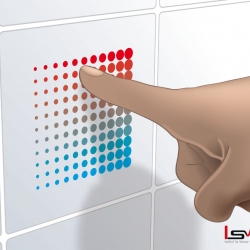Measurement methods based on ultrasonic waves have been used for many years for non-destructive material testing. Classical applications of ultrasound in industry are the detection of defects, the inspection of weld seams and bonds and the measurement of material stresses.
These methods usually use piezoelectric transducers to generate and measure sound waves. For these, however, a coupling medium between the workpiece to be examined and the transducer is always required. This, however, is often undesirable and prevents an automated measuring routine as it is required in industrial processes.
Sound waves can also be generated and measured without contact. For this purpose, optical methods or electromagnetic acoustic sound transducers are usually used. ISAT has developed a method and a device with which so-called surface acoustic waves can be excited contactlessly on the surface of solids. These waves are particularly suitable for the detection and characterization of layer systems, stresses or crack detection. With the optical method of laser excitation of ultrasound, a wide range of wave types can be generated. The energy input of the laser onto a substrate causes stresses in the material which propagate as ultrasonic waves through the material. A narrow, well focused line produces high bandwidths and amplitudes, and the short laser pulse produces a high frequency bandwidth. After the surface acoustic waves have passed over the test piece, they can be measured optically, for example interferometrically with laser Doppler vibrometry. With this approach it is possible to investigate micro and macro defects on one surface at the same time. Broadband surface acoustic waves can be used for crack detection. High frequency surface acoustic waves are completely reflected by deep cracks due to their low penetration depth. On the other hand, low frequency waves are hardly affected by microcracks due to their high penetration depth.
.


